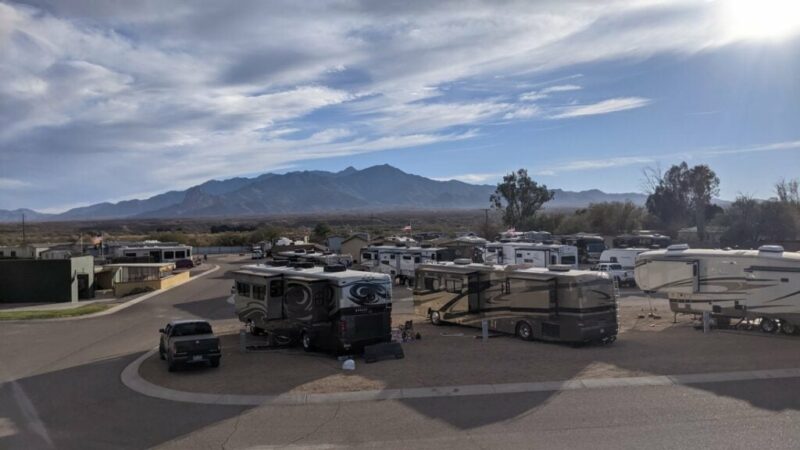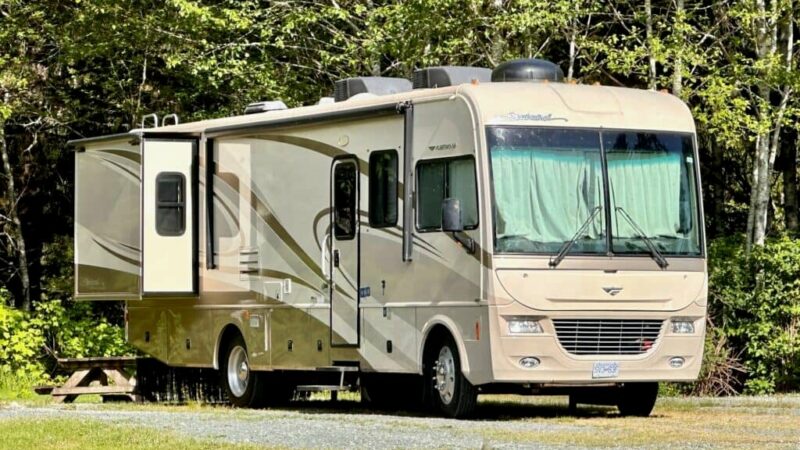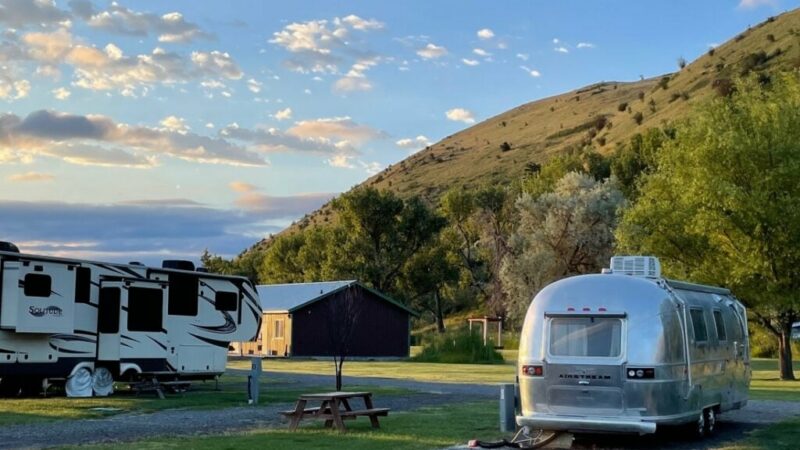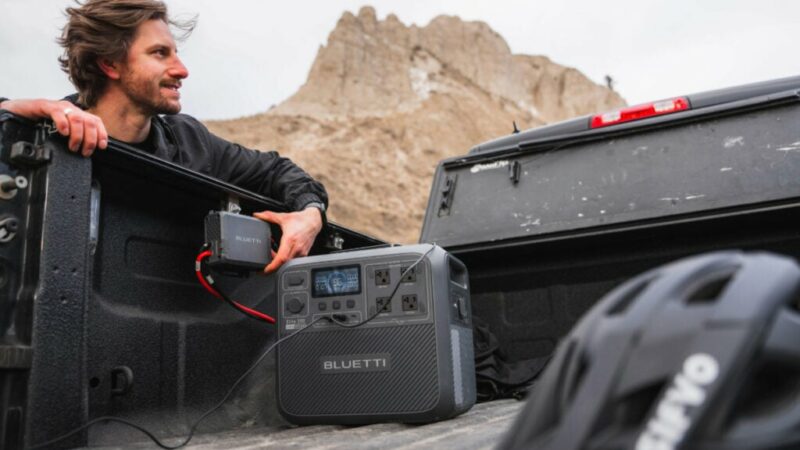The Ultimate Guide to Trailer Brake Controllers for Safe RV Towing
A trailer brake controller manages the operation of electric brakes on a trailer, allowing the driver to control the braking force
When you’re hauling an RV trailer down the road, enduring intermittent fits of road rage, tailgaters, and suspiciously slow traffic in the passing lane, your RV brake controller is your best friend. “Safety” is a word that gets thrown around a lot in the RV industry, but it’s rarely defined beyond innocuous references to components, common practices, and preventative maintenance drills.
An RV trailer brake controller ensures the trailer stops in sync with the tow vehicle—simple, yet complex in ways soon to be revealed. It’s your key to safe and confident towing.
We’ll go over why they are essential, how they work, and the best options on the market (because this is one of those devices you don’t want to go cheap on). If you’re new to RVing, this is something that will help paint the picture of towing an RV safely. For everyone else, knowledge is power.
Why Trailer Brake Controllers are Essential for RV Towing
Without an RV trailer brake controller, your tow vehicle is tasked with stopping the full weight of itself and the rig. Maybe not such a big deal for a teardrop. But it’s an entirely different scenario for a Grand Design Solitude, which has a dry weight between 15,000 and 16,000 pounds.
“In most states you’re going to need a brake controller to stay legal and keep you out of court if there’s an accident.”
Many of us like to brag about our trucks, but that’s a lot of weight to bring to a screeching halt on a dime. Imagine doing it downhill. But brake controllers have more value than just synchronized stopping power.
- Enhanced safety and control: Kind of goes without saying, but can’t be emphasized enough. Brakes are applied in proportion to the vehicle’s braking intensity, or with a preset intensity.
- Protection for tow vehicle and trailer: Less wear and tear on the tow vehicle, especially the tow vehicle’s brakes, thanks to distributed braking force. Brake controllers also prevent trailer brake lockup.
- Legal requirements: Gotta keep things on the straight and narrow. Brake controllers are mandatory in many regions throughout the United States and Canada, depending on the travel trailer’s or fifth-wheel’s weight.
- Adaptability to load and conditions: “Gain” and “Boost” options allow drivers to fine-tune their performance based on weight, road conditions, and weather. Modern controllers also offer versatility, supporting multiple trailer profiles and working with electric and electric-over-hydraulic brakes. Do you have more than one rig? Here you go.
- Critical for RV-specific scenarios: Sharing the load prevents “brake fade,” especially in mountainous terrain and steep grades. This is essential for emergency stops and boondocking, where rough roads and uneven terrain are more common.
One of the most important factors is stopping distance. This is huge for new RVers, still getting accustomed to hauling a rig around. It takes a little while to get used to that stopping distance and the oppressive feel of all that weight and force from behind, as that red light is rapidly approaching.
For those who journey to Canada from time to time, our northern neighbors have similar weight-based requirements up there. But always take the time to check ahead.
How Trailer Brake Controllers Work
Simply put, an RV trailer brake controller is a device in the tow vehicle that manages the operation of electric brakes on a trailer, allowing the driver to control the braking force so you don’t roll over the vehicle in front of you. There are different types of brake controllers (more on that below), but that’s the meat and potatoes of it.
Function and Operation
If you’re not satisfied with the definition above, I’m here for you. Now you get to read as I ramble on with a more thorough explanation.
- Driver Input: The RV trailer brake controller is connected to the vehicle’s brake system and electric system via a 7-pin trailer connector. When the driver presses the brake pedal, the controller detects the action either through the vehicle’s brake light circuit or the brake pedal.
- Signal Processing: The controller is responsible for interpreting the brake intensity (how hard you slam your foot down on the brake) and, in some models, the vehicle’s deceleration. It calculates the appropriate electrical current to send to the trailer’s brakes.
- Power Delivery: The controller sends a variable current (12 volts DC) through the wiring and to the trailer’s brake magnets. Stronger brake intensity increases current, strengthening the magnetic force, which presses the brake shoes against the drums on the trailer’s wheels.
- Manual Override: In general, the RV trailer brake controller has a manual slider or button that allows the driver to engage the trailer’s brakes independently of the tow vehicle’s brakes (which helps control trailer sway).
Types of Brake Controllers
For electric systems, there are three types of brake controllers. There are also hydraulic surge brakes, which are featured on some travel trailers and fifth-wheels, but they don’t require brake controllers (more on that below).
Timer-Based (Proportional)
A timer-based brake controller sends a preset amount of power to the trailer brakes, though there is a slight delay between the moment you engage the brakes to the moment the trailer’s brakes kick in.
These timer-based controllers are simple, affordable, and less precise than the remaining two. They lack precision because they are preset, with a gradual ramp-up, regardless of the tow vehicle’s rate of deceleration in real time. On the positive side, they’re generally good for lightweight trailers, simple tow vehicles, mild terrains, infrequent RV trips, and for those who are on a tight budget.
| Pros | Cons |
|---|---|
| Affordable (Between $50–$100) | Less Precise |
| Simple Installation Process | Poor Performance in Demanding Scenarios |
| Low Maintenance | Limited Adjustability |
| Adequate for Lightweight Trailers | Less Comfort |
| User-Friendly | Basic Features |
Inertia-Based (Proportional)
Unlike the timer-based RV trailer brake controller, the inertia-based variation relies on an accelerometer to sense the tow vehicle’s deceleration. It matches the trailer’s brake force to the tow vehicle’s. This creates a smoother and more responsive braking feel.
“Do you really want to save money with a time delay controller? If I have a vehicle pull out in front of me, I want braking immediately! P3 or P4 are well respected. I use a P4.”
Inertia-based controllers are good for heavier travel trailers and fifth-wheels, especially if you expect some varied terrain encounters throughout your many journeys.
| Pros | Cons |
|---|---|
| Precision Braking | Higher Cost (Between $150–$200) |
| Safer for Heavier Loads | Complex Installation |
| Versatility | Calibration Needs |
| Improved Braking Comfort | Maintenance Needs |
| Adjustable Settings | Potential Overkill for Lightweight Trailers |
| Breakaway Compatibility |
Smart/Integrated/OEM
Some modern vehicles have built-in controllers that integrate with the vehicle’s electronics, or aftermarket-installed variations. This offers the driver several advanced features, like trailer sway control or dashboard-provided diagnostics.
| Pros | Cons |
|---|---|
| Seamless Integration | Expensive (Adds to Factory Costs or Expensive as an Aftermarket Add-On) |
| Advanced, Accessible Features | Vehicle Compatibility is Limited to Newer Tow Vehicles |
| Highly Precise | Complex Setup for Aftermarket Variations |
| Ideal for Heavy Towing | Creates Potential Over-reliance |
| Enhanced Safety Features | Maintenance Complexity |
OEM or Smart Trailer Brake Controller
There’s a slight difference between an OEM (Original Equipment Manufacturer) and a smart brake controller. Smart controllers are typically aftermarket, installed to fully integrate with and leverage the vehicle’s advanced electronics. They offer features like proportional braking, sway control, and a full suite of diagnostics. For the most part, these are the same, though the distinction can be made between aftermarket and OEM.
Some older model tow vehicles (pre-2010 trucks) came equipped with OEM controllers, but they were simpler, lacking modern smart features like sway control and diagnostics. If you have an OEM/Smart controller, you’re likely driving 2020+ model Ford F-250s, Chevy Silverado, or RAM 3500s. Some OEM/Smart controllers go back as far as 2015 models.
These brake controllers offer proportional braking, dashboard information, and are compatible with electric and electric-over-hydraulic brake systems.
Hydraulic Surge Brakes
The only reason these are in the article is that some new RVers will confuse these for an RV trailer brake controller. Hydraulic surge brakes are usually found on smaller travel trailers, with GVWRs less than 7,000 pounds. Hydraulic surge brakes are comprised of a self-contained braking system that uses the force of the trailer, as it pushes against the tow vehicle, to activate hydraulic fluid pressure and compress the master cylinder.
The “surge actuator” is located in the trailer’s hitch coupler and is responsible for sensing deceleration. Where brake controllers communicate from vehicle to trailer through the tow vehicle’s brake system, hydraulic surge brakes only communicate from the hitch coupler, based on the application of force.
Airstream Basecamps, nuCamp Tabs, and Forest River R-Pods feature this type of braking system.
Popular Aftermarket Trailer Brake Controllers
Of course, if your tow vehicle doesn’t come equipped with a proper RV trailer brake controller, there are plenty of aftermarket options on the, uh, market. Besides, they offer flexibility, portability, and some come with advanced features, like Bluetooth communication.
Timer-Based Aftermarket Controllers
The last thing you want to do is jump on Amazon or some RV online marketplace and snatch up a brake controller because it looks good. Like everything else in retail, there are good ones and bad ones, and all brake controllers have their benefits and drawbacks. When dealing with timer-based controllers, you’re exchanging precision for affordability, so be cautious with your purchase.
CURT Venturer NEXT
The CURT Venturer NEXT is an affordable option ($60–$100) that’s reliable without the higher cost of proportional or OEM/Smart controllers. It features a slim, low-profile design, a modern aesthetic, and helps to minimize your dashboard clutter. It has a plug-n-play setup with a vehicle-specific CURT wiring harness, adjustable settings, a user-friendly interface, and a limited lifetime warranty.
REESE Towpower Brakeman IV
The Reese Towpower Brakeman IV is designed for trailers with one- to four axles. It’s priced around $70–$80 on Amazon. It’s compact, flexible, and affordable, which are three solid selling points. It features output and sync controls, so you can customize it for the trailer’s weight. The digital display feeds you enough info for adjustments and daily use.
Inertia-Based Aftermarket Controllers
There’s little doubt that an inertia-based, aftermarket RV trailer brake controller is the go-to, preferred device amongst most RVers. They’re much more precise, smooth, and ideal for heavier trailers, especially if you are a frequent RVer and spend time boondocking or going off-grid into rough terrain.
Tekonsha Prodigy P3 Proportional
The Tekonsha Prodigy P3 is often thought of as a top-tier RV trailer brake controller on the market. It’s hard to argue with that assertion. It features a triple-axis accelerometer and is highly versatile, user-friendly, and extremely precise. It supports 1 to 4 axles, features an LCD, and is probably one of the simplest options to operate. Adjusting the gain and boost is a simple press of the button.
It’s customizable as well, so you can personalize it to your own tastes, at least to a degree. For an additional safety touch, you can use the override to correct sway. It’s also surprisingly easy to install, which is a huge benefit for those who prefer not to spend the extra money on a professional install. MSRP is just below $250.
REDARC Tow-Pro Elite
The REDARC Tow-Pro Elite isn’t up there in popularity with the Tekonsha P3, but it’s a surprisingly high-quality alternative. It features dual-braking modes and off-road capabilities that other proportional brake controllers lack. Like the Tekonsha P3, it has a three-axis accelerometer and a “proportional” mode that auto-adjusts braking when decelerating for smoother stops.
The main unit is about the size of a large deck of cards, which is part of what makes it a popular option—the concealment factor and dashboard decluttering.
Installation considerations
Professional installation will run the average RVer $200+. You can get it done at most RV dealerships, trailer and towing specialty shops, and automotive repair/customization shops.
If you decide to go with a DIY approach, most timer-based controllers mount under the dash, while proportional variations may require calibration and a wiring harness that’s specific to your vehicle.
Choosing the Right Brake Controller for Your RV
There are five primary considerations: Trailer weight, axle count, towing frequency, vehicle compatibility, and budget preference. Not every RV trailer brake controller is created equally, but it’s doubtful you’ll run into anything so expensive you have to sell your kidney on the black market and refinance your home to obtain.
- Lightweight Trailers <3,000 lbs: Stick with a timer-based, preferably the CURT Venturer.
- Heavy trailers >5,000 lbs: Proportional, like the Tekonsha P3 or REDARC Tow-Pro Elite.
- Tech-Savvy RVers: Bluetooth models like the CURT Echo Mobile.
- Excellent Vehicle Integration: Look for advanced aftermarket options, like the Tuson DirectLink.
- Multiple Trailer Profiles: The Prodigy P3 can handle different RV and trailer types, in case you tow more than the same one.
- Dash Declutter: Look for compact, flexible, easy-to-install options like the REDARC Tow-Pro Elite
Assess your trailer, evaluate your towing needs, check your tow vehicle, set a budget, compare features, and research your installation options.
“The Tekonsha P3 is the best. I had that on my last truck. I had the P2 before that. Neither is as good as the built in one in my F-150 though but for an add on, the P3 is the best you can get.”
Regardless of what you decide on, take your time looking them over. It’s a really good idea to research the reviews behind each one. Jump on RV forums like iRV2, Forest River Forums, Air Forums, Jayco Owners, etc. If you’re just kicking off your RV journey, RVers are often more than happy to offer their personal experiences and information.
Conclusion
And, there it is. The RV trailer brake controller in all its glory and magnificence. Well, it won’t look that way, mounted on your dash or elsewhere, but you’ll certainly agree if it keeps your RV from sideswiping another vehicle while you’re going 60+ mph.
I threw around the term “affordable” a bit, but it’s really just a matter of a few degrees. Even proportional, high-end brake controllers won’t break the bank. If you need it, then it’s the one to go for. Professional installs aren’t that bad either, though you can probably get into the $600+ realm with a professional install of a high-end device.
Just be sure to go through a full assessment of your RV and towing vehicle needs before you decide, and check with other RVers. Speaking of which, be sure to explore RV Life, the forums, and our other resources and articles on towing tips. Also, feel free to list your RV trailer brake controller preference or ask questions in our comment section below!
The post The Ultimate Guide to Trailer Brake Controllers for Safe RV Towing appeared first on RV LIFE.
Source: https://rvlife.com/the-ultimate-guide-to-trailer-brake-controllers-for-safe-rv-towing/






